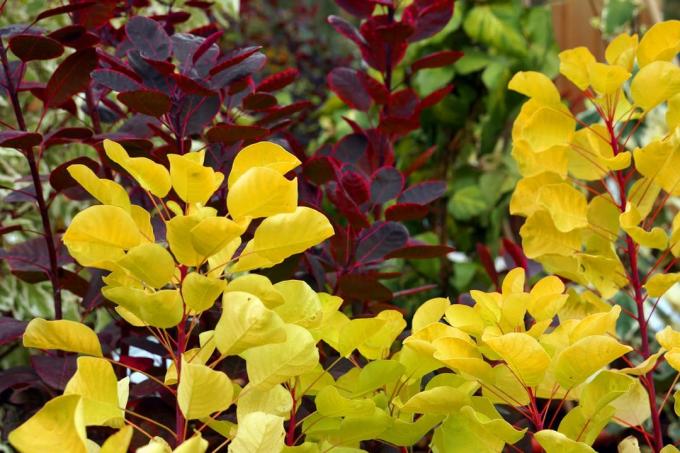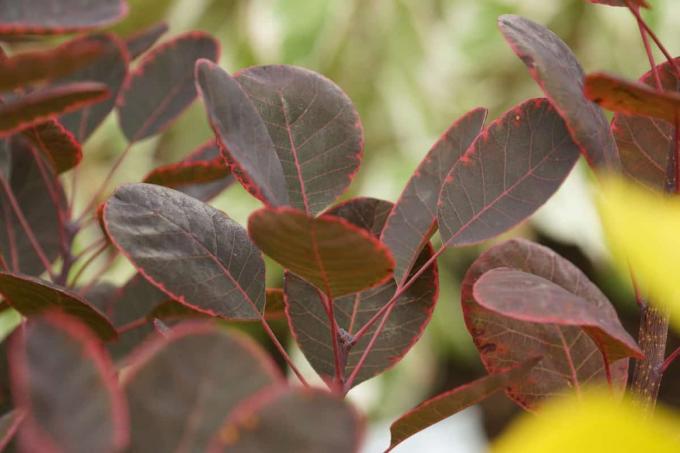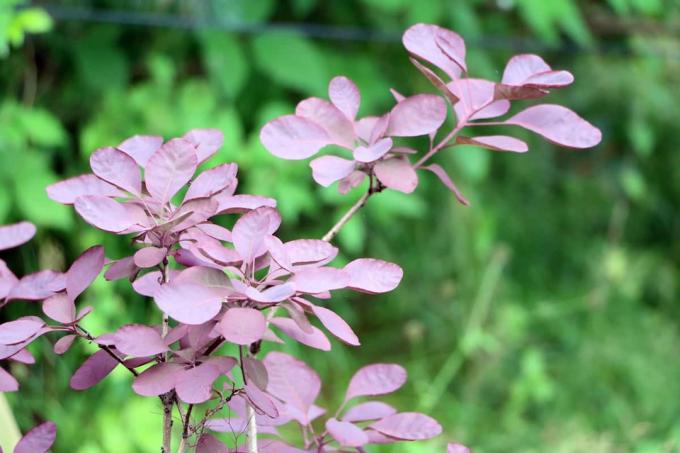

Table of contents
- location and soil
- Plant
- use
- propagation
- Pour
- Fertilize
- Cut
- tub cultivation
- hibernate
- diseases and pests
- toxicity
the smoke bush (Cotinus coggygria) brings a rich splendor of color to the home garden with its bright red foliage during the autumn period. The ornamental shrub imported from the Mediterranean requires special care in our latitudes.
location and soil
The smoke tree, which originated in the Mediterranean, is a child of the sun. Although it can also thrive in partially shaded places, it only achieves its full potential in a light-flooded location. In contrast, the plant is quite frugal in terms of soil requirements. The shrub is extremely adaptable and is satisfied with almost all cultivated soils. However, well-drained, dry and nutrient-rich soils with a high lime content and medium nutrient content are preferred. In the case of heavy and compacted soils with a tendency to waterlogging, there is a tendency for Verticillium wilt to develop. This is a fungal disease that is usually fatal. The optimal pH is between 6.5 and 7.5.
Tip:
A layer that serves as drainage, for example made of potsherds, can be used to minimize moisture.
Plant
Specimens from the specialist trade come almost exclusively from tub cultures. If the container or pot has sufficient roots, nothing stands in the way of planting all year round. The situation is different with shrubs cultivated outdoors, which should be planted outside of the growing season.
Tip:
An ideal location should be chosen before planting. Already established shrubs are difficult to transplant without damage.
Generally speaking, spring is ideal for transplanting the plant. If the temperatures are mild during the winter months, even autumn is suitable in these regions.

Of course, good soil conditions should be present in any case. Heavy and compacted soils can be improved with a dose of sand, for example. The plant pit when setting the plant itself should have twice the diameter and twice the depth of the root ball. Before actually planting, the root ball should be loosened up for better growth and generously soaked in a bucket of water. After planting, the willow tree should be watered properly.
use
The ornamental shrub is ideal as a solitary plant on open lawns. Its unique infructescence, which depends on the variety, and its foliage, which shines in different shades of red, attracts all the attention in parks and gardens. Although the plant proves itself ideal as a true single player in a solitary position, it does Plant also in combination with ornamental grasses, other colorful autumn trees or perennials chic. The shrub also comes into its own in large rock gardens or, due to its high resistance to drought, in roof gardens or on terraces in a container culture. The following plants are suitable as good planting partners:
- marigolds
- summer asters
- jewelry basket
- privet hedges
propagation
Propagation can be done in a variety of ways. The smoke bush can be propagated quite conventionally by sowing during the spring months. However, this project is not always crowned with success. More promising is propagation via sinkers. This also happens in the spring. To do this, a large side shoot that reaches down to the ground must be lowered into the ground and fixed firmly. At least 30 centimeters of the shoot tip should protrude from the earth. This sinker develops sufficient roots during the spring and summer growing season to allow for separation from the mother plant and relocation. This type of propagation often happens quite involuntarily through the natural growth of the shrub. These naturally occurring sinkers can easily be cut off and replanted elsewhere in the garden for propagation.
Pour
Watering the rather frugal wig tree according to a fixed pattern is rather counterproductive. Watering as needed makes more sense. This occurs when the surface of the earth has dried to a depth of around 5 centimetres. The plant does not make high demands on the irrigation water. Normal tap water is sufficient for watering. During extremely dry summer periods, there is sometimes a need to water several times a week. During dry months in spring, watering every two weeks is sufficient. Watering is done with a watering can or a garden hose. Avoid sprinkling the leaves and blossoms here, the irrigation water should be poured directly onto the tree disc.
Tip:
As a shallow-rooted plant, this shrub requires external irrigation during hot dry periods. However, it is essential to avoid waterlogging. If there is a lack of water, this is signaled by limp foliage.
The optimal amount of water or the water requirement results from several factors such as the size of the plant, the condition of the soil and the prevailing temperatures. In general, the rare watering with larger amounts of daily gifts is preferable. During the first year, it may be necessary to give 10 to 20 liters of water every two weeks.

Fertilize
Even locations with a low supply of nutrients are sufficient for the willow tree. Accordingly, the fertilization of this plant proves to be quite uncomplicated. It is usually sufficient if the shrub is generously supplied with organic garden fertilizer or compost before its growing season in spring. Unlike most plants, however, the willow tree prefers mineral soil, which is why other fertilizers are preferable to compost. The organic fertilizer develops a long-term effect over time. Accordingly, additional fertilization is only necessary in July. Plants planted outdoors are not the only ones to be fertilized, potted cultures should also be fertilized once a month during the spring months up to the end of August with a special perennial fertilizer.
Tip:
In order to ensure that the wood matures properly, the willow tree should never be fertilized over August.
Cut
In principle, the wig tree can be cut throughout the year due to its excellent cut compatibility. However, it does not require regular pruning to form a beautiful crown or reliable flowering. If the shoots are too lush, the shoots lying on the ground can be cut off directly at the base.
Caution:
Older specimens are less cut-resistant. Older specimens that have been severely pruned will not flower the following year.
Since pruning generally does not encourage flowering, pruning is only necessary for trimming or shaping. Stronger pruning of the crown is best done in late winter.
tub cultivation
If there is no possibility of planting outdoors or if the shrub is to stand on a roof terrace or balcony, the shrub places special demands on its care. Basically, smaller varieties should be used for a tub culture. A large planter is suitable for the usual smoke bush. As in the field, the choice of a permeable substrate is of great importance. The vessel itself should have a minimum depth of 70 centimeters and a minimum diameter of 80 centimeters. Clay or a bed of gravel is suitable as a drainage layer to avoid waterlogging. The use of high-quality potting soil ensures lush growth. As with other tub cultures, constant and regular watering is essential for the plant to thrive. Neither waterlogging nor periods of drought are conducive to the development of the plant. The crop must also be protected from extreme cold and frost.
Tip:
In general, tub cultures are much more sensitive than specimens planted outdoors.

hibernate
The perennial smoke smoker can even withstand icy temperatures of a maximum of -20 degrees. The younger a specimen, the more sensitive the plants are to cold temperatures. Freshly planted shrubs are also quite sensitive to cold and react negatively to night frost. So that they are not damaged during the cold winter months, young plants should at best overwinter in a frost-free but cool place. Old and well-rooted shrubs are more resistant, but here too, in extreme frosts, there is a need for additional winter protection in the form of a layer of brushwood. In our latitudes and the rather mild winters of recent years, however, such protection is only rarely necessary. Other diseases can also affect the shrub. Other common diseases include mildew, which can be combated by severe pruning or the use of fungicides.
diseases and pests
With good care and an appropriate location, the wig tree proves to be extremely stubborn. It is rarely attacked by pests or plants. However, the plant is relatively often affected by the so-called Verticillium wilt, which at first glance is often confused with dryness. The key symptoms of wilt include falling branches and wilting leaves despite adequate watering. A piece of the bark can be removed for diagnosis. If the water channels of the plant are discolored brown, this indicates the disease.
The disease is caused by a harmful fungus found in the soil. Plants that have been affected can no longer be cured. Optimal culture conditions can serve as a preventive protection against infection.
toxicity
In general, the smoke bush is considered poisonous. It is similar in toxicity to poison ivy and vinegar tree. The shrub is poisonous due to the flavones it contains, such as quercetin, which can lead to skin irritation and irritation. Not all species contain this contact poison. Predominantly specimens with red leaves contain this poison.
Tip:
Due to its toxic properties, pruning should only be carried out with appropriately safe gloves.
 garden editorial
garden editorial I write about everything that interests me in my garden.
Learn more about P like Primrose
Purple bells - profile, care tips and propagation
The Heuchera, the purple bell, originally comes from America, from Canada to Mexico. Today there are numerous, beautiful hybrids with a wide variety of leaf shapes, colors and flowers for home gardens to buy. The Heuchera species are evergreen, clump-forming perennials from the Sacifragaceae family.
pushkinia; Puschkinia libanotica – care for early bloomers
Blooms early, blooms enchantingly. Is hardy, durable and easy to care for. But despite all these advantages, the Puschkinia is still almost an insider tip. The delicate white flowers of this bulbous plant sway out of their long, light green leaves. The Puschkinia libanotica belongs to the plant family of the asparagus family (Asparagaceae).

London Plane, Platanus acerifolia - Planting & Care
The maple-leaved plane is a very good avenue tree, a fast-growing and tall tree with large leaves almost identical to those of the maple.

Petunias, Petunia – common diseases and pests
Petunias are among the most popular balcony and tub plants. Their abundance of flowers and the numerous varieties in different colors and with different patterns make these plants so popular. However, petunias are also a bit sensitive and sometimes downright bitchy if they don't find all the conditions they would like.
Plant pampas grass - location, distance, fertilizing & Co
Pampas grass is garden usually stands out from the rest of the planting. This tall grass with its impressive bud sites is hard to miss. It works best as a solitaire. After a few years, a really large eyrie has developed. In a solitary position, perhaps in the middle of the lawn, the pampas grass looks more than good. In addition, it is also extremely easy to care for.

Instructions: Cut the chanterelle tree - this is how it's done!
The pipe bush is usually referred to as false jasmine, sometimes also as farmer's or summer jasmine. This flowering shrub has many names. Typical of the chanterelle tree are the numerous white flowers, simple, semi-double or double and an intense fragrance. Not all varieties smell, but most do, sometimes more, sometimes less.
